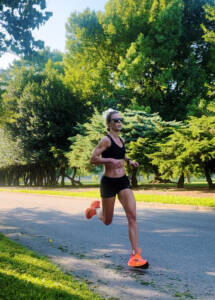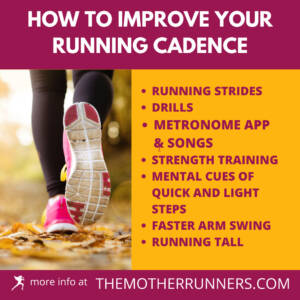Want to know what one of the most common questions new athletes ask me as their running coach? How do I increase my running cadence (aka increase the number of steps I take in a minute)? The idea that a 180 cadence is the gold standard in running is prevalent among elite runners and recreational runners alike.
These runners think that if they can increase their steps to 180 per minute, that means their running form is perfect, and they will run faster easier.

However, this is not always true. A 180 cadence is not a natural stride rate for many runners because running cadence is affected by many things you CANNOT change like how tall you are, for example.
But some people do need to change their cadence. I have some athletes that come to me with a lower running cadence (in the low 150s) or a higher running cadence (210s for easy pace) plus other concerns about running injuries, etc. For these runners, we take a closer look at their stride rate and running form to ensure we are moving in the most efficient way when we’re running.
My experience increasing my running cadence
I had worked on having a faster cadence when returning from a hamstring tear. I trained at a high level with a hamstring tear for about six months. During this time, my injured leg (right foot) lagged behind my healthy leg (left foot).

My running cadence slowed by about ten steps per minute (from the upper 170s to the upper 160s). As I returned to running, I worked on quickening my stride so that both my legs were moving in lockstep. This not only improved my running economy but also reduced my risk of injury. I’ll share how I did this below.
Related: 7 Hamstring Exercises for Runners
In this article, I will cover:
- What is a running cadence?
- What is an optimal running cadence (& what factors affect running cadence)?
- Can your running cadence make you run faster? And can it prevent injury?
- How can you tell if you need to improve your running cadence?
- And, how to get a higher running cadence (if you need to).
Let’s get going.
What is running cadence?
Running cadence is the same as your stride rate or step rate. A running cadence is the number of Steps you take Per Minute (SPM). When people refer to a 180 running cadence, it means your feet hit the ground 180 times per minute—or 90 steps on each foot per minute. Many running watches will calculate your running cadence.
Related: Your Garmin Metrics Explained
Just like there is no one perfect running gait as we are all individual snowflakes floating around on the roads, trails, and track—there is no ideal cadence number. What’s a perfect cadence for you may be totally different than what’s a perfect cadence for your friend. (Let that be a lesson in life…).
How can this be? Well, your running cadence is affected by several factors such as:

- Height
- Strength
- Body mechanics (how your body moves through its gait cycle) including
- Vertical oscillation rate (aka bouncing aka how much your torso moves vertically when running), and
- Stride length
The last one is very important as your running speed is dictated by your running cadence (steps per minute) and stride length (how big your steps are).
This is why you could run the same pace as your friend, but you have a cadence of 185 and she has a cadence of 165. What’s going on here?
Well, her stride length is probably longer than yours so she covers more ground with each step. Chances are she’s a taller runner than you, too. Taller runners typically have a slower cadence as their legs are longer and take longer strides. Shorter runners have a faster cadence because their legs turnover quicker.
Is 180 an optimal cadence for runners?
What’s the deal with 180 being the optimal cadence for runners? Well, the 180 number came from a study esteemed running coach Jack Daniels did in 1984. Daniels decided to count the number of steps elite runners took in a 3k race. He found the average cadence (or number of steps per minute) to be 180.
But when you look at a study like this, it’s important to look at the context. First of all, these were elite runners running on a track.
Secondly, these runners were running a 3k race which is pretty close to max effort (just under a 2-mile race). The faster you run, the higher cadence you will have (plus a longer stride rate as you are hitting the ground with more force). The slower you run (including marathon pace and easy run pace), the slower your cadence (and shorter stride rate—don’t forget the equation for running speed).
Related: Benefits of an Easy Run Pace
A similar study was performed decades later in 2018 which examined 100k runners at the World Championship (so, a much longer distance, I’d say). The cadence of these elite runners varied from 155 to 203. Ultra-running great Jim Walmsley has a cadence closer to 165!
Does increasing cadence improve running performance?

Some studies suggest that a higher running cadence can make you a faster better runner. A 2019 study had runners work on running cadence for 15 minutes a day over 10 days (going from 176 to 180). The researchers found that running economy (or the energy used to run) improved as evidenced by a lower heart and oxygen consumption rate.
This essentially means the runner could run faster using less fuel after just 10 days of cadence training.
Ok, now what about injury prevention?
Related: How to Return to Running After Injury
Does a faster cadence decrease injury risk?
The research is mixed on whether a faster running cadence decreases injury risk.
One would assume that taking shorter steps would reduce the impact on your joints since each step has less force behind it. Also, if you take shorter, faster steps, you likely aren’t over-striding which is one of the leading causes of injury.
When you overstride, your leg is straighter and stiffer, and likely lands in front of your body, with your heel braking your stride and absorbing the force as you land. This can lead to injuries from your feet all the way to your kinetic chain to your hip. You want to land with your foot below your knee.
Related: Kettlebell Workout for Runners
So, what does the research say about cadence and injury risk?
- A 2018 study found that a higher running cadence decreased loading and braking impulses which both can lead to injury.
- A 2014 meta-review found that increased cadence reduced biomechanical irregularities that could lead to injury.
- A 2021 review found that increasing running cadence can reduce the risk for bone-stress injuries.
- Another 2021 study, on the other hand, found no connection between the injuries of 550 runners and their running cadence.
- Finally, another study in 2018 of injured and uninjured runners found no connection between cadence and injuries and injury risk,
It’s important to remember that our bodies are complicated. If you’ve had a running injury, then you know this. It can be hard to figure out what caused your running injury. You could have the most beautiful running stride with a perfect individual cadence, but your big toe is slightly inverted or you have a minor bone deformity in your hip that makes you injury prone.
That above paragraph is part of me venting, by the way. I don’t have perfect running form but I have a healthy, balanced form and do all the things (pre-hab, re-hab, strength training, sleep well, eat well, train right) and I have still battled major injuries throughout my running career. There are many pieces of the running and running injury puzzle and your cadence is just one of them.
Related: How I Stopped Being an Injury-Prone Runner
Should you improve your cadence?
So, how can you tell if you should improve your cadence? I’m of the mind that if isn’t broken, then don’t fix it. If you are running well without injury, then do not mess with your running cadence or running form.
But if you are getting frequent injuries, feel tired on easy runs, or feel inefficiencies in your stride, then increasing your running cadence could help.
(But remember, running cadence is part of the overall massive running pie. Proper nutrition, hormone, and nutrient levels, recovery, sleep, biomechanics, training, etc. all factor into running economy as well as your health.)
Related: How Much Should I Run in a Day?
There are safe and effective ways to increase your cadence. Here’s how.
7 Ways to Increase Your Running Cadence
Running strides.
After an easy run twice a week, try running four strides over 100 meters. Strides teach the body how to move efficiently.
Strides are not sprints. They are gradual accelerations of speed so that you are running at close to top speed in the middle for about 10 seconds. Fully recover and repeat.

Running strides help your brain better communicate with your muscles on how to move using less energy. Strides on flat ground and hill strides (half the distance, so 50 meters) helped me increase my cadence immensely.
Related: How to Run Strides (+ Why You Should)
Drills.
Running drills such as high knees, carioca, butt kicks, and A/B skips help your body learn how to move efficiently—just like strides. Do these 8 running drills twice a week to improve your running efficiency along with the other practices in this list.
Fast arms.
When running, instead of focusing on moving your legs faster, you can work on moving your arms faster. Keep your arms swinging fluidly by your sides and increase the rate of which they swing. The cadence of your legs will naturally follow the cadence of your arms.
Stand tall.
Proper running form for all runners includes running tall with a slight lean and your head over hips and feet landing under knees. If your feet land in front of your knee, this is over-striding and can impact your cadence—and lead to injuries. A more efficient stride will land with your feet under your center of gravity.
Therefore, if you focus on running tall with your feet under you, you may naturally improve your running cadence.
Related: What is Proper Running Form?
Metronome.
A popular way of increasing running cadence is downloading a metronome app and programming the goal step number, or finding a song list with songs that have 180 beats per minute and then trying to match your cadence with the beat on your phone or watch. This can be mentally taxing and not very fun. Also, remember 180 is not a natural stride rate for many runners.
That said, it can still help you quicken your stride. If you do this, reserve it for just about 15 minutes a run for about two weeks.
Mental cue.
Perhaps the simplest way to increase your cadence is to remind yourself as your running to have quick and light feet.
This is something all runners want because the longer your feet are on the ground, the more energy you are wasting and the higher risk for injury. By cueing yourself to have quick and light feet, you will naturally quicken your turnover and improve your running cadence.
Strength train.
One of the factors you can change that help determine your cadence is your leg strength. The stronger your legs, the more force you exert with each stride. This can lengthen and quicken your step.
Strength training twice a week with simple strength exercises such as squats, lunges, and single-leg deadlifts can help increase your step power and stride frequency.
Related: Strength Training Guide for Runners
These exercises to improve your running cadence are low risk and high reward for making you a healthier, better runner.
If you want guidance with your running goals, including during perimenopause or menopause, check out my run coaching services. Also, be sure to check out my free training plans:
- Postpartum Training Plan
- After a Break Training Plan
- 5k Training Plans
- 10k Training Plans
- Half Marathon Training Plans
- Marathon Training Plans
- Strength Training Plan
